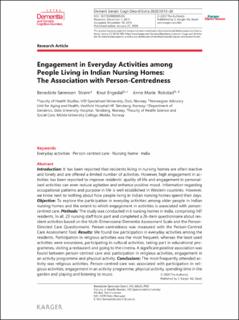| dc.contributor.author | Strøm, Benedicte Sørensen | |
| dc.contributor.author | Engedal, Knut | |
| dc.contributor.author | Rokstad, Anne Marie Mork | |
| dc.date.accessioned | 2022-11-09T14:22:11Z | |
| dc.date.available | 2022-11-09T14:22:11Z | |
| dc.date.created | 2020-01-24T20:15:04Z | |
| dc.date.issued | 2020 | |
| dc.identifier.citation | Dementia and geriatric cognitive disorders extra. 2020, 10 (1), 13-26. | en_US |
| dc.identifier.issn | 1664-5464 | |
| dc.identifier.uri | https://hdl.handle.net/11250/3030992 | |
| dc.description.abstract | Introduction: It has been reported that residents living in nursing homes are often inactive and lonely and are offered a limited number of activities. However, high engagement in activities has been reported to improve residents’ quality of life and engagement in personalized activities can even reduce agitation and enhance positive mood. Information regarding occupational patterns and purpose in life is well established in Western countries. However, we know next to nothing about how people living in Indian nursing homes spend their days. Objective: To explore the participation in everyday activities among older people in Indian nursing homes and the extent to which engagement in activities is associated with personcentred care. Methods: The study was conducted in 6 nursing homes in India, comprising 147 residents. In all, 23 nursing staff took part and completed a 26-item questionnaire about resident activities based on the Multi-Dimensional Dementia Assessment Scale and the Person- Directed Care Questionnaire. Person-centredness was measured with the Person-Centred Care Assessment Tool. Results: We found low participation in everyday activities among the residents. Participation in religious activities was the most frequent, whereas the least used activities were excursions, participating in cultural activities, taking part in educational programmes, visiting a restaurant and going to the cinema. A significant positive association was found between person-centred care and participation in religious activities, engagement in an activity programme and physical activity. Conclusions: The most frequently attended activity was religious activities. Person-centred care was associated with participation in religious activities, engagement in an activity programme, physical activity, spending time in the garden and playing and listening to music. | en_US |
| dc.language.iso | eng | en_US |
| dc.rights | Attribution-NonCommercial-NoDerivatives 4.0 Internasjonal | * |
| dc.rights.uri | http://creativecommons.org/licenses/by-nc-nd/4.0/deed.no | * |
| dc.title | Engagement in everyday activities among people living in Indian nursing homes : the association with person-centredness | en_US |
| dc.type | Peer reviewed | en_US |
| dc.type | Journal article | en_US |
| dc.description.version | publishedVersion | en_US |
| dc.source.pagenumber | 13-26 | en_US |
| dc.source.volume | 10 | en_US |
| dc.source.journal | Dementia and geriatric cognitive disorders extra | en_US |
| dc.source.issue | 1 | en_US |
| dc.identifier.doi | 10.1159/000505396 | |
| dc.identifier.cristin | 1781875 | |
| cristin.unitcode | 211,2,0,0 | |
| cristin.unitname | Avdeling for helse- og sosialfag | |
| cristin.ispublished | true | |
| cristin.fulltext | original | |
| cristin.qualitycode | 1 | |

